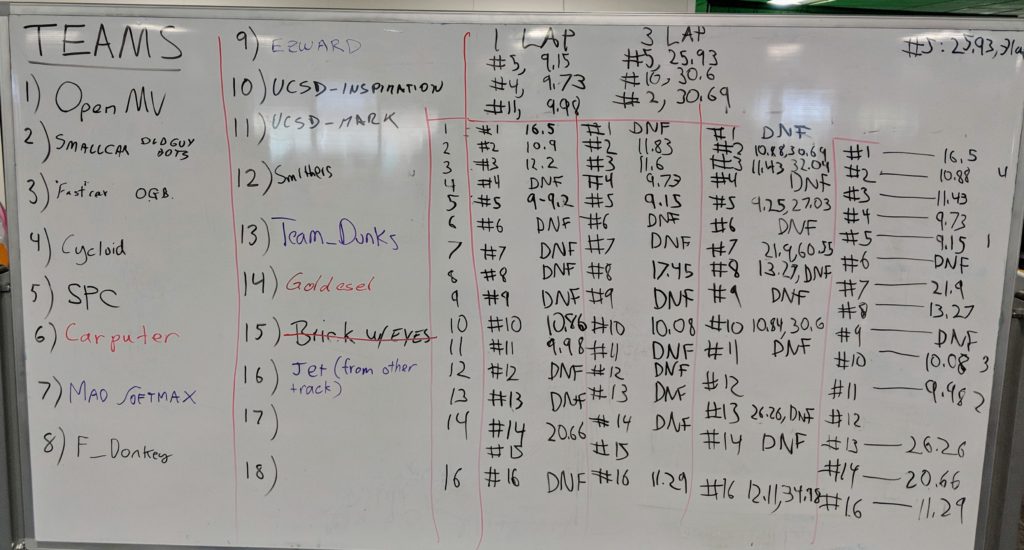Now that the DIY Robocars quarterly races in Oakland have gotten big and the cars fast, it’s time to evolve the rules to reflect our learnings over the past two years.
As of the Sept 21 2019 race, these are the new rules:
There are two tracks, one for beginners and a main one for returning racers:


- There are 12″ orange cones on the inside of every curve, as shown above.
- There will be one “obstacle cone” placed at a random location (changed with every race) inside the track.
- The Beginners Track has the same shape, but is about 25% smaller
If this is your first race or your car’s first race, you must start on the Beginners Track. There will be one judge on that track to schedule official runs. If you can successfully complete a lap in under 40 seconds, you may advance to the Main Track and place your team name on the lineup board (example from a recent race shown below).

Main Track Rules:
Cars:
- Cars must start with a single binary interaction. This could be a button on the car, on a controller, a key on a keyboard or equivalent. No other intervention can happen until after the race is over; otherwise the car gets a “did not finish” (DNF). An emergency stop button is recommended but not required. Deadman’s switch is also acceptable where button is pushed and held for the duration of the race.
- There are no rules governing where the computing needs to take place. Cars may have onboard computing, trackside computing or leverage remote or cloud resources.
- GPS and other similar positioning systems are not allowed except for specified outdoor races.
- The desire is that this is an open source league and that all designs are put on github and are readily copyable after the conclusion of every race. If you are prevented from open-sourcing designs or prefer not to, there is no obligation to do so.
There are two categories of racers: Stock and Unlimited
1) Stock:
- This includes all the standard platforms: DonkeyCar, JetRacer, DeepRacer as well as any custom vehicles that satisfy the below criteria
- Cars are 1/16th scale or smaller: No more than a 7.5″ (190mm) wheelbase, axle to axle.
- Cost no more than $400 all told (car, computer, sensors, etc)
- Batteries must be firmly attached with velcro or other straps so they can’t come loose during the race
2) Unlimited:
- This is for cars larger and/or more expensive than Stock
- Cars may be up to two feet long and may weigh up to 10lbs
- No limit on cost (although we do encourage DIY economics — if you’ve spent $10,000 on a Lidar sensor, this may not be the right event for you. Not only is it out of reach for others to follow, but in the obligatory Demolition Derby at the end it may very well get damaged)
- Batteries must be firmly attached with velcro or other straps so they can’t come loose during the race
Races:
- There are three heats, followed by a “ladder” race-off of the top six cars, paired by closest times, ending with a final race between the top two cars for the winning trophy (not actually a trophy!).
- All races will be “wheel-to-wheel” with two cars on the track at the same time
- Every car will have at least three opportunities to race. Only those in the top six will move on to the ladder.
- The first heat pairings are random, within the class they have entered. After that, the second and third heat pairings are based on matching closest times within their class in the first heat.
- Racers may choose to agree on track starting position (inside or outside lane). If they do not agree, the judge will flip a coin to decide.
- The final race is an all-cars Demolition Derby. If you brought a car, even if it didn’t qualify for the Main Track or even if it doesn’t even work autonomously, you will race. There will be crashes. It will be fun. It’s the best 30 seconds of mayhem of the day.
Scoring:
- Each heat is three laps. Both the first lap and the three-lap times will be recorded for each car, but only the first-lap time will determine ranking for the next heat (or ladder position)
- Passing any “curve cone” on the inside is immediate disqualification for that heat
- There is no penalty for going outside the white lines, as long as you don’t violate the cone rule above
- The random “obstacle cone” may be passed on either side. Hitting the obstacle cone imposes a two-second penalty
- Touching any other cone is a one-second penalty

Nvidia jetracer BOM calls out a 1/18th scale platform that is 10.4″ long. If this item is used will the body be required to be trimmed to 10″ or perhaps not installed?
The chassis is only 10″ long, according to my ruler. Car body shells are never used